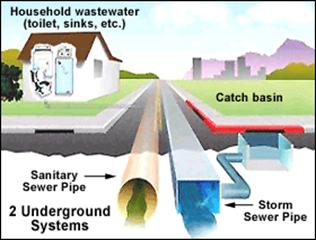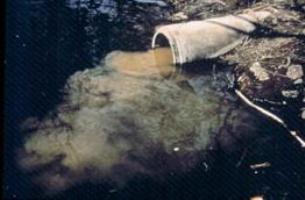What is Storm Water Runoff?
LEARN MORE ABOUT STORM WATER RUNOFF
Storm water runoff is rain and melting snow that flows off building rooftops, driveways, lawns, streets, parking lots, construction sites, and industrial storage yards. Developed areas are covered by buildings and pavement, which do not allow water to soak into the ground. Storm sewers are used to collect large amounts of runoff from streets and parking lots. But where does this water go?
Storm Sewers Discharge to Water Bodies
Storm sewers are pipes laid underground below streets. Unlike sanitary sewers that collect wastewater from homes and businesses and convey it to a wastewater treatment plant, storm sewers are separate pipes that collect storm water runoff from inlets, catch basins, or drains located along street curbs and in parking areas.
Most storm water does not go to a wastewater treatment plant for treatment. Only parts of three cities, Milwaukee, Shorewood and Superior have treatment of storm water at the wastewater treatment plant. Usually, storm water runoff flows overland or is discharged by storm sewers into nearby waterways or treatment devices. Waterways may be stream beds, rivers, or lakes. Treatment devices include rain gardens, swales, infiltration practices, wet ponds, and bioretention systems.
What's In Storm Water Runoff?
Pollutants on the streets and parking lots get washed away with the storm water runoff into waterways. Here are some of the types of pollutants in storm water runoff.
- Garbage
- Oil and grease
- Gasoline
- Sediment from construction sites and urban runoff
- Metal flakes from rusting vehicles and brakes
- Road salt
- Lawn pesticides
- Agricultural herbicides
- Heavy metals from roof shingles
- Pet waste
- Leaves
- Grass clippings
- Bacteria
- Nutrients such as phosphorus and nitrogen
- Other chemicals
- Illicit discharges such as paints, cleaning solution products and used motor oil.
Storm water is not clean and it can pollute our streams and lakes. Contaminated storm water is the most significant contributor of pollutants to Wisconsin's urban waters today. These types of pollutants can harm fish and wildlife populations, kill native vegetation, foul drinking water supplies, and make recreational areas unsafe and unpleasant. Read more about storm water pollutants in Why is storm water runoff a problem?


